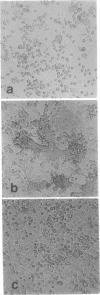Abstract
Several aromatic mono- and diamidines were found to block cell fusion induced by respiratory syncytial virus. The best inhibitors were able to achieve complete suppression of syncytium formation at a concentration of 1.0 microM. Inhibition occurred in respiratory syncytial virus-infected HEp-2 and CV-1 cells, but the same inhibitors were ineffective in preventing fusion induced by parainfluenza virus type 3. The fusion inhibitors did not reduce single-cycle virus yields, but did reduce multiple-cycle yields. In addition, the active compounds caused a significant retardation of respiratory syncytial virus penetration. The mechanism by which amidines interfere with respiratory syncytial virus-host cell interactions is unknown, but parallels can be drawn between antiviral activity and the ability of the compounds to inhibit certain trypsin-like proteases.
Full text
PDF

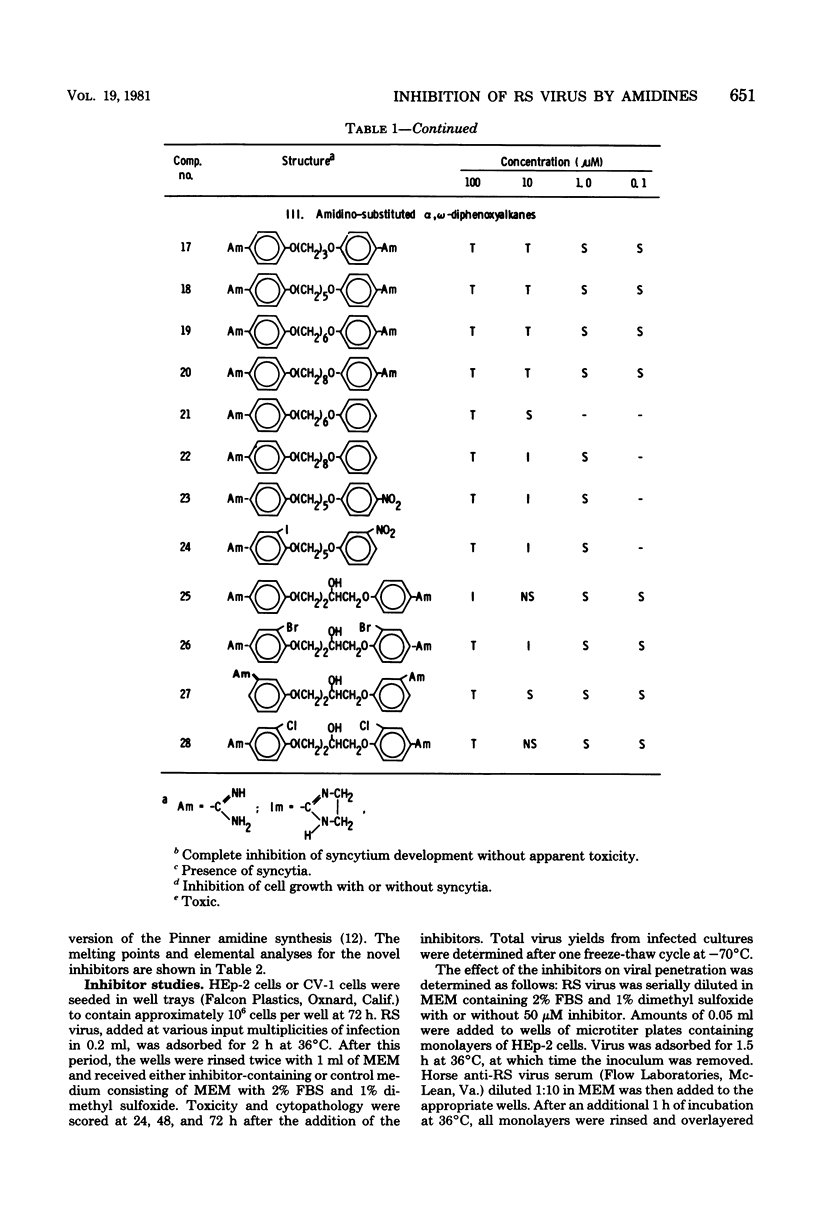

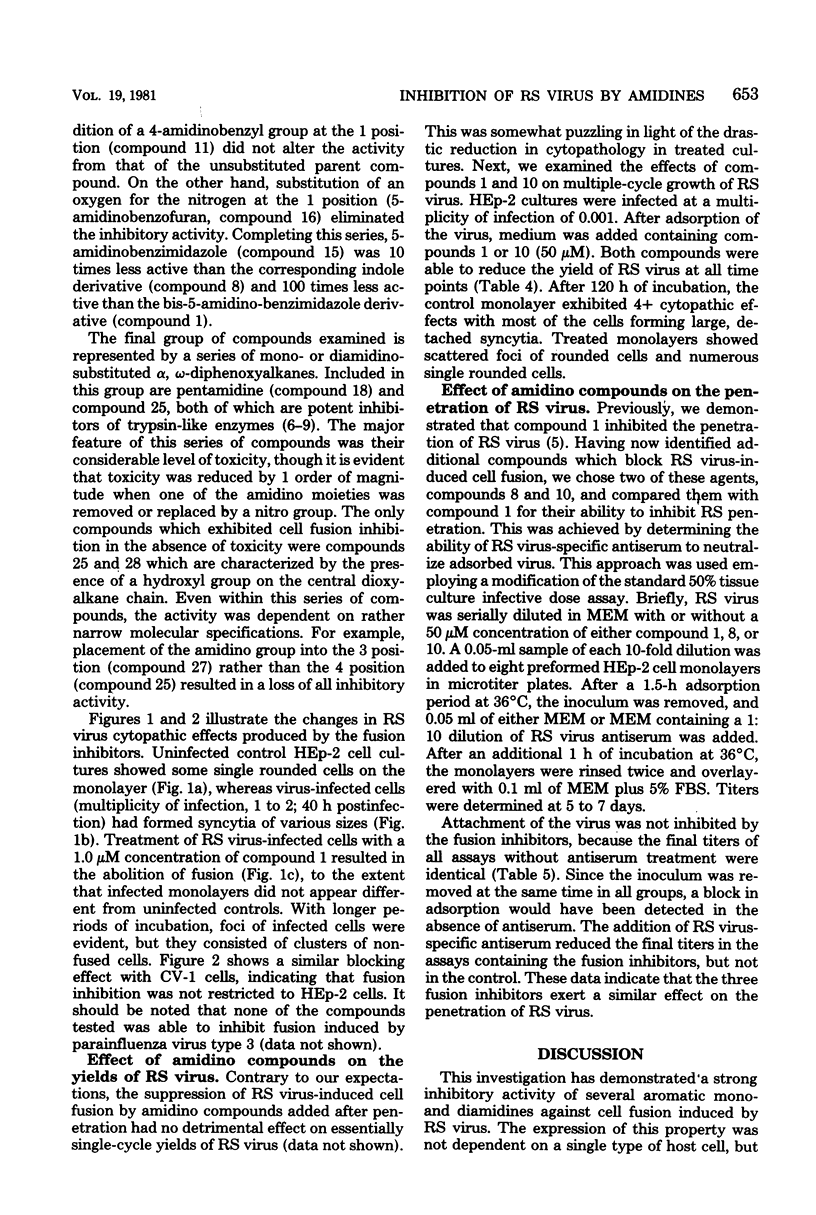

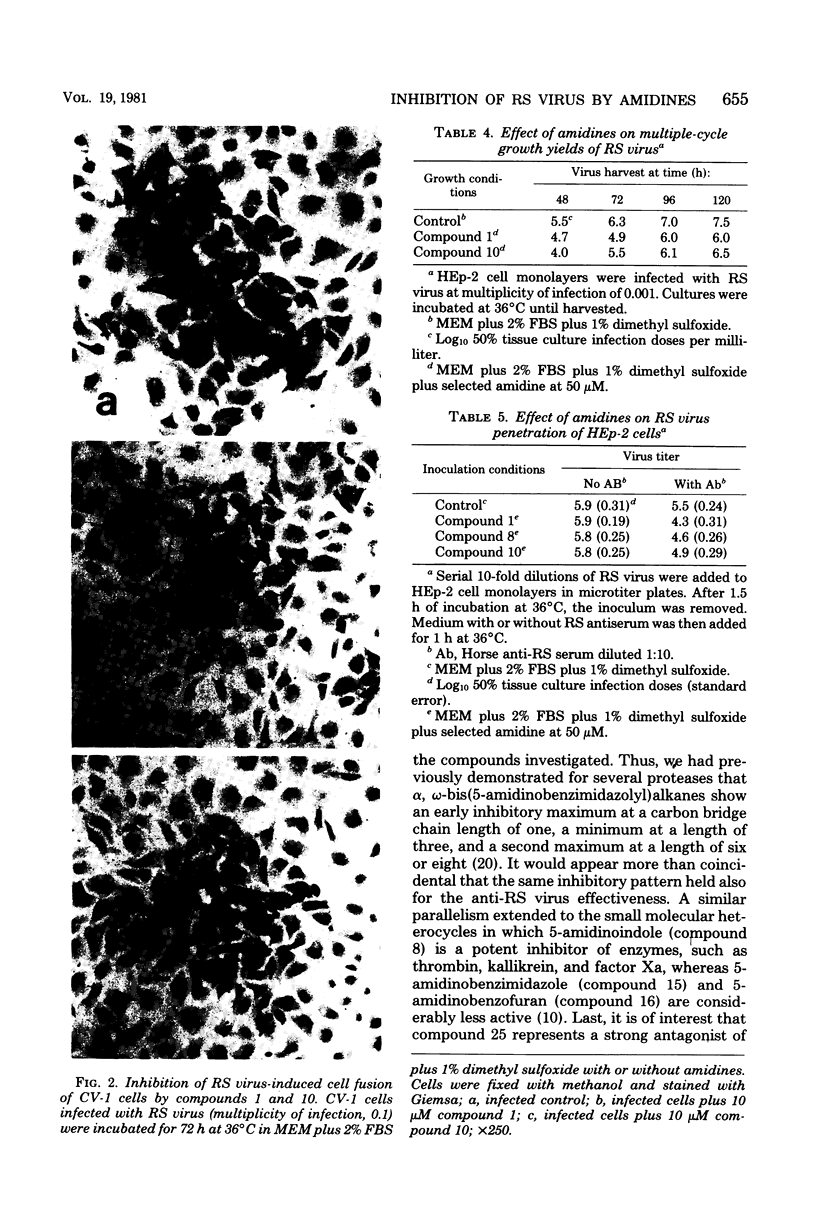
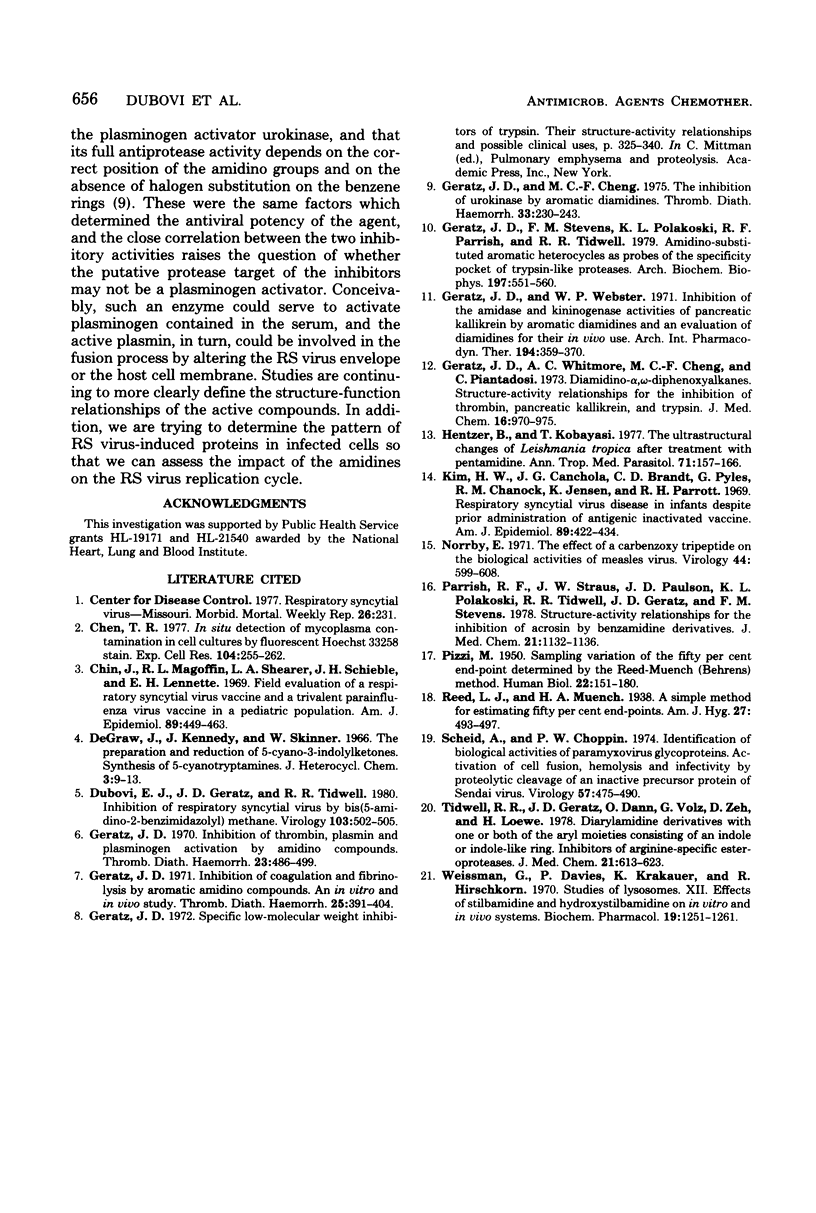
Images in this article
Selected References
These references are in PubMed. This may not be the complete list of references from this article.
- Chen T. R. In situ detection of mycoplasma contamination in cell cultures by fluorescent Hoechst 33258 stain. Exp Cell Res. 1977 Feb;104(2):255–262. doi: 10.1016/0014-4827(77)90089-1. [DOI] [PubMed] [Google Scholar]
- Chin J., Magoffin R. L., Shearer L. A., Schieble J. H., Lennette E. H. Field evaluation of a respiratory syncytial virus vaccine and a trivalent parainfluenza virus vaccine in a pediatric population. Am J Epidemiol. 1969 Apr;89(4):449–463. doi: 10.1093/oxfordjournals.aje.a120957. [DOI] [PubMed] [Google Scholar]
- Dubovi E. J., Geratz J. D., Tidwell R. R. Inhibition of respiratory syncytial virus by bis(5-amidino-2-benzimidazolyl)methane. Virology. 1980 Jun;103(2):502–509. doi: 10.1016/0042-6822(80)90207-x. [DOI] [PubMed] [Google Scholar]
- Geratz J. D., Cheng M. C. The inhibition of urokinase by aromatic diamidines. Thromb Diath Haemorrh. 1975 Apr 30;33(2):230–243. [PubMed] [Google Scholar]
- Geratz J. D. Inhibition of coagulation and fibrinolysis by aromatic amidino compounds. An in vitro and in vivo study. Thromb Diath Haemorrh. 1971 Jun 30;25(3):391–404. [PubMed] [Google Scholar]
- Geratz J. D. Inhibition of thrombin, plasmin and plasminogen activation by amidino compounds. Thromb Diath Haemorrh. 1970 Jun 30;23(3):486–499. [PubMed] [Google Scholar]
- Geratz J. D., Stevens F. M., Polakoski K. L., Parrish R. F., Tidwell R. R. Amidino-substituted aromatic heterocycles as probes of the specificity pocket of trypsin-like proteases. Arch Biochem Biophys. 1979 Oct 15;197(2):551–559. doi: 10.1016/0003-9861(79)90279-0. [DOI] [PubMed] [Google Scholar]
- Geratz J. D., Webster W. P. Inhibition of the amidase and kininogenase activities of pancreatic kallikrein by aromatic diamidines and an evaluation of diamidines for their in vivo use. Arch Int Pharmacodyn Ther. 1971 Dec;194(2):359–370. [PubMed] [Google Scholar]
- Geratz J. D., Whitmore A. C. Diamidino-alpha,omega-diphenoxyalkanes. Structure-activity relationships for the inhibition of thrombin, pancreatic kallikrein, and trypsin. J Med Chem. 1973 Sep;16(9):970–975. doi: 10.1021/jm00267a003. [DOI] [PubMed] [Google Scholar]
- Hentzer B., Kobayasi T. The ultrastructural changes of Leishmania tropica after treatment with pentamidine. Ann Trop Med Parasitol. 1977 Jun;71(2):157–166. doi: 10.1080/00034983.1977.11687174. [DOI] [PubMed] [Google Scholar]
- Kim H. W., Canchola J. G., Brandt C. D., Pyles G., Chanock R. M., Jensen K., Parrott R. H. Respiratory syncytial virus disease in infants despite prior administration of antigenic inactivated vaccine. Am J Epidemiol. 1969 Apr;89(4):422–434. doi: 10.1093/oxfordjournals.aje.a120955. [DOI] [PubMed] [Google Scholar]
- Norrby E. The effect of a carbobenzoxy tripeptide on the biological activities of measles virus. Virology. 1971 Jun;44(3):599–608. doi: 10.1016/0042-6822(71)90374-6. [DOI] [PubMed] [Google Scholar]
- PIZZI M. Sampling variation of the fifty percent end-point, determined by the Reed-Muench (Behrens) method. Hum Biol. 1950 Sep;22(3):151–190. [PubMed] [Google Scholar]
- Parrish R. F., Straus J. W., Paulson J. D., Polakoski K. L., Tidwell R. R., Geratz J. D., Stevens F. M. Structure-activity relationships for the inhibition of acrosin by benzamidine derivatives. J Med Chem. 1978 Nov;21(11):1132–1136. doi: 10.1021/jm00209a008. [DOI] [PubMed] [Google Scholar]
- Scheid A., Choppin P. W. Identification of biological activities of paramyxovirus glycoproteins. Activation of cell fusion, hemolysis, and infectivity of proteolytic cleavage of an inactive precursor protein of Sendai virus. Virology. 1974 Feb;57(2):475–490. doi: 10.1016/0042-6822(74)90187-1. [DOI] [PubMed] [Google Scholar]
- Tidwell R. R., Geratz J. D., Dann O., Volz G., Zeh D., Loewe H. Diarylamidine derivatives with one or both of the aryl moieties consisting of an indole or indole-like ring. Inhibitors of arginine-specific esteroproteases. J Med Chem. 1978 Jul;21(7):613–623. doi: 10.1021/jm00205a005. [DOI] [PubMed] [Google Scholar]
- Weissmann G., Davies P., Krakauer K., Hirschhorn R. Studies on lysosomes. 13. Effects of stilbamidine and hydroxystilbamidine on in vitro and in vivo systems. Biochem Pharmacol. 1970 Apr;19(4):1251–1261. doi: 10.1016/0006-2952(70)90040-7. [DOI] [PubMed] [Google Scholar]



